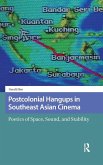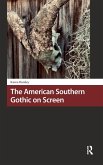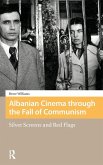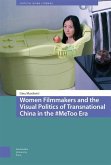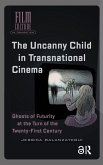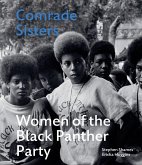- Gebundenes Buch
- Merkliste
- Auf die Merkliste
- Bewerten Bewerten
- Teilen
- Produkt teilen
- Produkterinnerung
- Produkterinnerung
This volume offers an organic discussion of Wang Bing's filmmaking across China's marginal spaces and against the backdrop of the state-sanctioned 'China Dream'. Wang Bing's cinema gives voice to the subaltern. Focusing on contemporary China, his work testifies to a set of issues dealing with inequality, labour, and migration.
Andere Kunden interessierten sich auch für
![Postcolonial Hangups in Southeast Asian Cinema Postcolonial Hangups in Southeast Asian Cinema]() Gerald SimPostcolonial Hangups in Southeast Asian Cinema142,99 €
Gerald SimPostcolonial Hangups in Southeast Asian Cinema142,99 €![The American Southern Gothic on Screen The American Southern Gothic on Screen]() Karen HorsleyThe American Southern Gothic on Screen132,99 €
Karen HorsleyThe American Southern Gothic on Screen132,99 €![Albanian Cinema through the Fall of Communism Albanian Cinema through the Fall of Communism]() Bruce WilliamsAlbanian Cinema through the Fall of Communism132,99 €
Bruce WilliamsAlbanian Cinema through the Fall of Communism132,99 €![Women Filmmakers and the Visual Politics of Transnational China in the #MeToo Era Women Filmmakers and the Visual Politics of Transnational China in the #MeToo Era]() Gina MarchettiWomen Filmmakers and the Visual Politics of Transnational China in the #MeToo Era161,99 €
Gina MarchettiWomen Filmmakers and the Visual Politics of Transnational China in the #MeToo Era161,99 €![The Uncanny Child in Transnational Cinema The Uncanny Child in Transnational Cinema]() Jessica BalanzateguiThe Uncanny Child in Transnational Cinema133,99 €
Jessica BalanzateguiThe Uncanny Child in Transnational Cinema133,99 €![Japanese Filmmakers in the Wake of Fukushima Japanese Filmmakers in the Wake of Fukushima]() Mitsuyo Wada-MarcianoJapanese Filmmakers in the Wake of Fukushima142,99 €
Mitsuyo Wada-MarcianoJapanese Filmmakers in the Wake of Fukushima142,99 €![Comrade Sisters Comrade Sisters]() Stephen ShamesComrade Sisters35,99 €
Stephen ShamesComrade Sisters35,99 €-
-
-
This volume offers an organic discussion of Wang Bing's filmmaking across China's marginal spaces and against the backdrop of the state-sanctioned 'China Dream'. Wang Bing's cinema gives voice to the subaltern. Focusing on contemporary China, his work testifies to a set of issues dealing with inequality, labour, and migration.
Produktdetails
- Produktdetails
- Verlag: Routledge
- Seitenzahl: 242
- Erscheinungstermin: 15. Juli 2021
- Englisch
- Abmessung: 240mm x 161mm x 18mm
- Gewicht: 531g
- ISBN-13: 9789463721837
- ISBN-10: 9463721835
- Artikelnr.: 62214431
- Herstellerkennzeichnung
- Libri GmbH
- Europaallee 1
- 36244 Bad Hersfeld
- gpsr@libri.de
- Verlag: Routledge
- Seitenzahl: 242
- Erscheinungstermin: 15. Juli 2021
- Englisch
- Abmessung: 240mm x 161mm x 18mm
- Gewicht: 531g
- ISBN-13: 9789463721837
- ISBN-10: 9463721835
- Artikelnr.: 62214431
- Herstellerkennzeichnung
- Libri GmbH
- Europaallee 1
- 36244 Bad Hersfeld
- gpsr@libri.de
Elena Pollacchi is Senior Lecturer in Chinese Studies and has taught courses on Chinese-language film and documentary cinema, Asian cinema, and contemporary Chinese culture at Ca' Foscari University of Venice (Italy), Stockholm University, and Gothenburg University (Sweden). She holds a PhD from Cambridge University in Chinese film studies and has published extensively on Chinese-language film and documentary cinema, film festivals, and film production and exhibition circuits. She is a member of the selection committee and programmer for Chinese-language film and South Korean cinema at the Venice International Film Festival.
Acknowledgements
Foreword by Alberto Barbera
INTRODUCTION
1. The relevance of Wang Bing's filmmaking
2. Themes
form and narrative structure: A linked approach to Wang Bing's filmmaking
3. Wang Bing à la Wong Kar-wai
4. Genesis and book's structure
1. WANG BING'S CINEMATIC JOURNEY: A COUNTER-NARRATIVE OF THE CHINA DREAM
1. The centrality of space in Wang Bing's narrativized reality
2. Chinese marginal spaces and uneven development
3. Wang's counter-journey of the China Dream
4. Spaces in Wang Bing's oeuvre: an overview of the films and issues at stake
2. HISTORY IN THE MAKING: THE DEBUT EPIC TIEXI QU: WEST OF THE TRACKS
1. The debut epic Tiexi qu: West of the Tracks and its context
2. West of the Tracks as a contemporary cinematic reportage
3. Filming 'history in the making' and the legacy of the Lumière films
4. Towards an epic of labour: from Terrence Malick's Days of Heaven to West of the Tracks
3. SPACES OF LABOUR: THREE SISTERS
'TIL MADNESS DO US PART
BITTER MONEY
1. Filming spaces of labour and cinema as labour
2. The transition from the industrial space of Tiexi to rural and marginal spaces
3. Three Sisters: an epic of survival reminiscent of John Ford's The Grapes of Wrath
4. Duration in Wang Bing's cinema: the case of Three Sisters and Alone
5. No Way Out: from Three Sisters to 'Til Madness Do Us Part
6. 'Til Madness Do Us Part: the camera work between 'madness' and 'love'
7. Reaching the new centres of labour: Bitter Money
8. Bitter Money: earning money in hardship
4. SPACES OF HISTORY AND MEMORY: THE WORKS ON THE ANTI-RIGHTIST CAMPAIGN
PART I - A space too much: The Ditch
1. The genesis of The Ditch (2004-09)
2. The Ditch: carving out a space for documenting the past
3. Historical spectacles: Wang Bing's The Ditch and Pier Paolo Pasolini's Salò (1975)
4. Ghosts of the past: Wang Bing's The Ditch and Brutality Factory and Pedro Costa's Colossal Youth
PART II - Spaces of Memories: Dead Souls
1. From Fengming: A Chinese Memoir to Dead Souls
2. The genesis of Dead Souls
3. Spaces for survival: archiving audiovisual witnesses
4. The act of filming and spaces of death
5. Wang Bing's Dead Souls and Claude Lanzmann's Shoah (1985)
5. COLLECTIVE SPACES - INDIVIDUAL NARRATIVES: MAN WITH NO NAME
FANG XIUYING
GAO ERTAI - BEAUTY LIVES IN FREEDOM
1. Man With No Name: individual spaces of self-isolation
2. Fathers and Sons: individual spaces and deteriorating family structures
3. Mrs Fang: individual spaces of death
4. Mi Niang and Ta'ang: spaces of escape and refuge
5. Gao Ertai - Beauty Lives in Freedom: individual spaces of exile
6. CONCLUDING REMARKS: EXHIBITION SPACES AND SPACES OF HUMAN PRACTICE
Filmography
Bibliograhy
Index.
Foreword by Alberto Barbera
INTRODUCTION
1. The relevance of Wang Bing's filmmaking
2. Themes
form and narrative structure: A linked approach to Wang Bing's filmmaking
3. Wang Bing à la Wong Kar-wai
4. Genesis and book's structure
1. WANG BING'S CINEMATIC JOURNEY: A COUNTER-NARRATIVE OF THE CHINA DREAM
1. The centrality of space in Wang Bing's narrativized reality
2. Chinese marginal spaces and uneven development
3. Wang's counter-journey of the China Dream
4. Spaces in Wang Bing's oeuvre: an overview of the films and issues at stake
2. HISTORY IN THE MAKING: THE DEBUT EPIC TIEXI QU: WEST OF THE TRACKS
1. The debut epic Tiexi qu: West of the Tracks and its context
2. West of the Tracks as a contemporary cinematic reportage
3. Filming 'history in the making' and the legacy of the Lumière films
4. Towards an epic of labour: from Terrence Malick's Days of Heaven to West of the Tracks
3. SPACES OF LABOUR: THREE SISTERS
'TIL MADNESS DO US PART
BITTER MONEY
1. Filming spaces of labour and cinema as labour
2. The transition from the industrial space of Tiexi to rural and marginal spaces
3. Three Sisters: an epic of survival reminiscent of John Ford's The Grapes of Wrath
4. Duration in Wang Bing's cinema: the case of Three Sisters and Alone
5. No Way Out: from Three Sisters to 'Til Madness Do Us Part
6. 'Til Madness Do Us Part: the camera work between 'madness' and 'love'
7. Reaching the new centres of labour: Bitter Money
8. Bitter Money: earning money in hardship
4. SPACES OF HISTORY AND MEMORY: THE WORKS ON THE ANTI-RIGHTIST CAMPAIGN
PART I - A space too much: The Ditch
1. The genesis of The Ditch (2004-09)
2. The Ditch: carving out a space for documenting the past
3. Historical spectacles: Wang Bing's The Ditch and Pier Paolo Pasolini's Salò (1975)
4. Ghosts of the past: Wang Bing's The Ditch and Brutality Factory and Pedro Costa's Colossal Youth
PART II - Spaces of Memories: Dead Souls
1. From Fengming: A Chinese Memoir to Dead Souls
2. The genesis of Dead Souls
3. Spaces for survival: archiving audiovisual witnesses
4. The act of filming and spaces of death
5. Wang Bing's Dead Souls and Claude Lanzmann's Shoah (1985)
5. COLLECTIVE SPACES - INDIVIDUAL NARRATIVES: MAN WITH NO NAME
FANG XIUYING
GAO ERTAI - BEAUTY LIVES IN FREEDOM
1. Man With No Name: individual spaces of self-isolation
2. Fathers and Sons: individual spaces and deteriorating family structures
3. Mrs Fang: individual spaces of death
4. Mi Niang and Ta'ang: spaces of escape and refuge
5. Gao Ertai - Beauty Lives in Freedom: individual spaces of exile
6. CONCLUDING REMARKS: EXHIBITION SPACES AND SPACES OF HUMAN PRACTICE
Filmography
Bibliograhy
Index.
Acknowledgements
Foreword by Alberto Barbera
INTRODUCTION
1. The relevance of Wang Bing's filmmaking
2. Themes
form and narrative structure: A linked approach to Wang Bing's filmmaking
3. Wang Bing à la Wong Kar-wai
4. Genesis and book's structure
1. WANG BING'S CINEMATIC JOURNEY: A COUNTER-NARRATIVE OF THE CHINA DREAM
1. The centrality of space in Wang Bing's narrativized reality
2. Chinese marginal spaces and uneven development
3. Wang's counter-journey of the China Dream
4. Spaces in Wang Bing's oeuvre: an overview of the films and issues at stake
2. HISTORY IN THE MAKING: THE DEBUT EPIC TIEXI QU: WEST OF THE TRACKS
1. The debut epic Tiexi qu: West of the Tracks and its context
2. West of the Tracks as a contemporary cinematic reportage
3. Filming 'history in the making' and the legacy of the Lumière films
4. Towards an epic of labour: from Terrence Malick's Days of Heaven to West of the Tracks
3. SPACES OF LABOUR: THREE SISTERS
'TIL MADNESS DO US PART
BITTER MONEY
1. Filming spaces of labour and cinema as labour
2. The transition from the industrial space of Tiexi to rural and marginal spaces
3. Three Sisters: an epic of survival reminiscent of John Ford's The Grapes of Wrath
4. Duration in Wang Bing's cinema: the case of Three Sisters and Alone
5. No Way Out: from Three Sisters to 'Til Madness Do Us Part
6. 'Til Madness Do Us Part: the camera work between 'madness' and 'love'
7. Reaching the new centres of labour: Bitter Money
8. Bitter Money: earning money in hardship
4. SPACES OF HISTORY AND MEMORY: THE WORKS ON THE ANTI-RIGHTIST CAMPAIGN
PART I - A space too much: The Ditch
1. The genesis of The Ditch (2004-09)
2. The Ditch: carving out a space for documenting the past
3. Historical spectacles: Wang Bing's The Ditch and Pier Paolo Pasolini's Salò (1975)
4. Ghosts of the past: Wang Bing's The Ditch and Brutality Factory and Pedro Costa's Colossal Youth
PART II - Spaces of Memories: Dead Souls
1. From Fengming: A Chinese Memoir to Dead Souls
2. The genesis of Dead Souls
3. Spaces for survival: archiving audiovisual witnesses
4. The act of filming and spaces of death
5. Wang Bing's Dead Souls and Claude Lanzmann's Shoah (1985)
5. COLLECTIVE SPACES - INDIVIDUAL NARRATIVES: MAN WITH NO NAME
FANG XIUYING
GAO ERTAI - BEAUTY LIVES IN FREEDOM
1. Man With No Name: individual spaces of self-isolation
2. Fathers and Sons: individual spaces and deteriorating family structures
3. Mrs Fang: individual spaces of death
4. Mi Niang and Ta'ang: spaces of escape and refuge
5. Gao Ertai - Beauty Lives in Freedom: individual spaces of exile
6. CONCLUDING REMARKS: EXHIBITION SPACES AND SPACES OF HUMAN PRACTICE
Filmography
Bibliograhy
Index.
Foreword by Alberto Barbera
INTRODUCTION
1. The relevance of Wang Bing's filmmaking
2. Themes
form and narrative structure: A linked approach to Wang Bing's filmmaking
3. Wang Bing à la Wong Kar-wai
4. Genesis and book's structure
1. WANG BING'S CINEMATIC JOURNEY: A COUNTER-NARRATIVE OF THE CHINA DREAM
1. The centrality of space in Wang Bing's narrativized reality
2. Chinese marginal spaces and uneven development
3. Wang's counter-journey of the China Dream
4. Spaces in Wang Bing's oeuvre: an overview of the films and issues at stake
2. HISTORY IN THE MAKING: THE DEBUT EPIC TIEXI QU: WEST OF THE TRACKS
1. The debut epic Tiexi qu: West of the Tracks and its context
2. West of the Tracks as a contemporary cinematic reportage
3. Filming 'history in the making' and the legacy of the Lumière films
4. Towards an epic of labour: from Terrence Malick's Days of Heaven to West of the Tracks
3. SPACES OF LABOUR: THREE SISTERS
'TIL MADNESS DO US PART
BITTER MONEY
1. Filming spaces of labour and cinema as labour
2. The transition from the industrial space of Tiexi to rural and marginal spaces
3. Three Sisters: an epic of survival reminiscent of John Ford's The Grapes of Wrath
4. Duration in Wang Bing's cinema: the case of Three Sisters and Alone
5. No Way Out: from Three Sisters to 'Til Madness Do Us Part
6. 'Til Madness Do Us Part: the camera work between 'madness' and 'love'
7. Reaching the new centres of labour: Bitter Money
8. Bitter Money: earning money in hardship
4. SPACES OF HISTORY AND MEMORY: THE WORKS ON THE ANTI-RIGHTIST CAMPAIGN
PART I - A space too much: The Ditch
1. The genesis of The Ditch (2004-09)
2. The Ditch: carving out a space for documenting the past
3. Historical spectacles: Wang Bing's The Ditch and Pier Paolo Pasolini's Salò (1975)
4. Ghosts of the past: Wang Bing's The Ditch and Brutality Factory and Pedro Costa's Colossal Youth
PART II - Spaces of Memories: Dead Souls
1. From Fengming: A Chinese Memoir to Dead Souls
2. The genesis of Dead Souls
3. Spaces for survival: archiving audiovisual witnesses
4. The act of filming and spaces of death
5. Wang Bing's Dead Souls and Claude Lanzmann's Shoah (1985)
5. COLLECTIVE SPACES - INDIVIDUAL NARRATIVES: MAN WITH NO NAME
FANG XIUYING
GAO ERTAI - BEAUTY LIVES IN FREEDOM
1. Man With No Name: individual spaces of self-isolation
2. Fathers and Sons: individual spaces and deteriorating family structures
3. Mrs Fang: individual spaces of death
4. Mi Niang and Ta'ang: spaces of escape and refuge
5. Gao Ertai - Beauty Lives in Freedom: individual spaces of exile
6. CONCLUDING REMARKS: EXHIBITION SPACES AND SPACES OF HUMAN PRACTICE
Filmography
Bibliograhy
Index.


